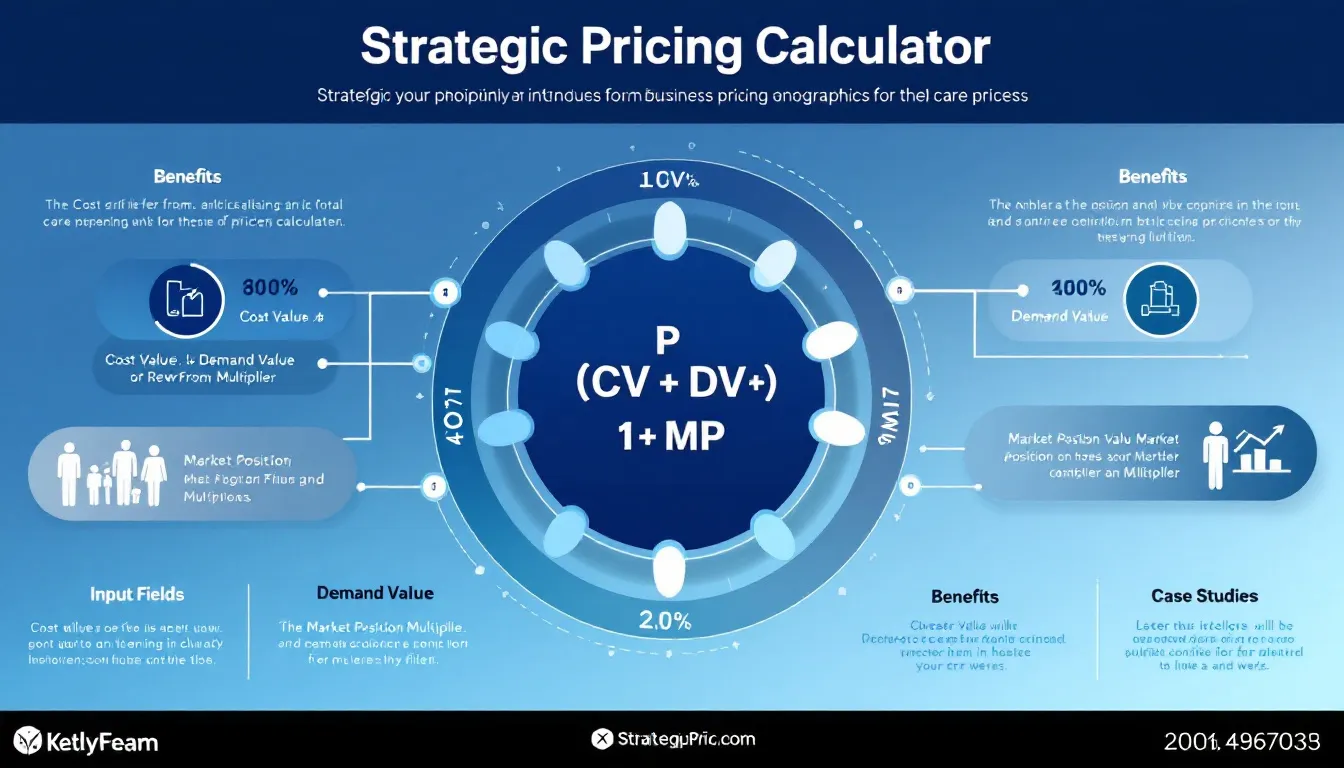Is this tool helpful?
How to Use the Pricing Strategy Calculator Effectively
This strategic pricing calculator helps you create a tailored pricing strategy by analyzing your unique business factors and market conditions. To get the best results, carefully fill in each field with relevant information about your business, products, and competitors.
Step-by-Step Input Guide
- Type of business or industry: Enter your business category clearly. Examples: “Custom software development” or “Sustainable home goods manufacturing”.
- Description of your product or service: Provide a detailed description focusing on features and advantages. Examples: “Smart irrigation system for urban gardens” or “Handmade ceramic kitchenware with eco-friendly glazing”.
- Description of your target market: Define your ideal customers using demographics and behaviors. Examples: “Young professionals aged 22-35 interested in tech gadgets” or “Families with children living in suburban areas”.
- Current competitor pricing information: List pricing models of direct and indirect competitors. This field is optional but improves accuracy. Examples: “Competitor X: $120/unit, Competitor Y: Tiered pricing $100-$180” or “Local artisans pricing: $80-$130”.
- Unique selling propositions or key features: Highlight what sets your product apart. Examples: “Energy-efficient design, lifetime warranty” or “Locally sourced materials, customizable options”.
Introduction to the Strategic Pricing Calculator
The pricing strategy calculator helps you develop an optimal pricing approach that matches your market position and business value proposition. It evaluates your inputs and suggests price points that balance profitability with buyer expectations, helping you gain a competitive edge and improve revenue.
By integrating data on your industry, product details, target customers, and competitor prices, this tool produces recommendations based on proven pricing principles. It guides you to set prices that reflect your unique selling points while remaining attractive in your market.
Practical Usage of the Pricing Strategy Calculator
This calculator functions as a form-based tool that sends your input data for server-side processing to generate personalized pricing strategies. You should use it to:
- Evaluate initial pricing when launching new products or services
- Adjust prices in response to competitor actions or market shifts
- Explore premium pricing opportunities based on your unique features
- Develop segmented pricing strategies for different customer groups
- Gain insights to refine your value propositions and marketing messages
Example Use Cases
- Artisan Coffee Roastery: Used the calculator to price specialty coffee blends, considering local competitors and emphasizing single-origin beans. Resulted in pricing 25% above average with strong customer retention.
- Online Language Learning Platform: Applied the tool to define subscription tiers based on features such as live tutoring and AI assessment, increasing average revenue per user by 35%.
Core Elements Behind Your Pricing Strategy
Your pricing must consider several strategic factors to position your product effectively:
- Market Positioning: How you compare to competitors and where your brand stands in customers’ minds
- Value-Based Pricing: Setting prices based on the perceived and delivered value to customers, not just costs
- Competitive Differentiation: Leveraging distinctive features that justify your price points
- Target Market Purchasing Power: Aligning prices with what your ideal customers are willing and able to pay
- Brand Premium Potential: Assessing how much extra your brand can command due to reputation or exclusivity
Advanced Pricing Formulas Used in This Tool
The calculator utilizes value-based pricing principles and market positioning metrics to suggest optimal pricing. The main formula is:
Where:
- P = Optimal Price Point
- CV = Core Value (base cost plus standard margin)
- DV = Differentiated Value (value from unique features and benefits)
- MP = Market Position Factor (brand premium potential)
The market position multiplier (MP) evaluates your market strengths as:
Where:
- USPscore: Unique Selling Proposition strength (rated 1-5)
- TMalignment: Target Market alignment factor (range 0.8-1.2)
- CMfactor: Competitive Market position factor (range 0.7-1.3)
Key Benefits of Using the Pricing Strategy Calculator
1. Gain a Clear Competitive Edge
You get data-backed pricing insights that help establish price points balancing profitability with customer acceptance. The tool encourages differentiation by incorporating your unique selling propositions directly into pricing.
2. Make Smarter Market Decisions
The calculator informs you about broader market trends, pricing behaviors of competitors, and customer value perceptions. This helps you anticipate shifts and adapt proactively.
3. Maximize Revenue Potential
With recommendations rooted in value-based principles, you can capture premium pricing opportunities or explore price skimming strategically to optimize earnings and market penetration.
Addressing Common Pricing Challenges
Pricing for Market Entry
When launching a new product, the calculator suggests prices that attract early adopters while navigating competitive pressures effectively.
Setting Prices for Premium Positioning
If you target upscale customers, the tool advises on how to justify price premiums with value communication, brand positioning, and unique features.
Frequently Asked Questions
How often should I update my pricing strategy?
Review your pricing strategy quarterly or whenever market conditions change significantly, such as new competitors entering or updates to your products.
Can I use this calculator for multiple products?
Yes, you should enter details separately for different products or services to create customized pricing strategies for each.
How do I factor seasonal pricing changes?
Include any expected seasonal pricing variations in your product description and competitor pricing fields for more accurate recommendations.
Why is brand positioning important for pricing?
Brand positioning affects customer perception of value and should be clearly reflected in your unique selling points and target market description to influence pricing effectively.
Important Disclaimer
The calculations, results, and content provided by our tools are not guaranteed to be accurate, complete, or reliable. Users are responsible for verifying and interpreting the results. Our content and tools may contain errors, biases, or inconsistencies. Do not enter personal data, sensitive information, or personally identifiable information in our web forms or tools. Such data entry violates our terms of service and may result in unauthorized disclosure to third parties. We reserve the right to save inputs and outputs from our tools for the purposes of error debugging, bias identification, and performance improvement. External companies providing AI models used in our tools may also save and process data in accordance with their own policies. By using our tools, you consent to this data collection and processing. We reserve the right to limit the usage of our tools based on current usability factors.







